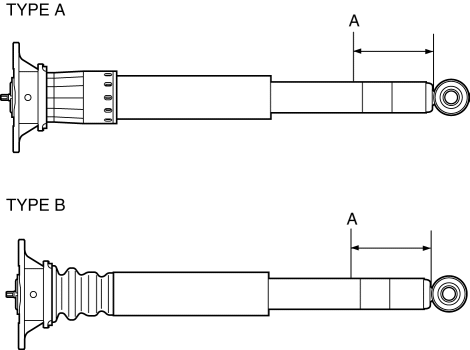Mazda CX-5 Service & Repair Manual: Rear Shock Absorber Disposal
WARNING:
-
Whenever drilling into a rear shock absorber, wear protective eye wear. The gas in the rear shock absorber is pressurized, and could spray metal chips into the eyes and face when drilling.
1. Clamp a rear shock absorber on a flat surface or with the piston pointing downwards.
2. Drill a 2—3 mm {0.08—0.11 in}
hole at point A from the bottom of the tube, so the gas can escape.

-
Point A: 40—50 mm {1.6—1.8 in}
3. Turn the hole downwards.
4. The oil can be collected by moving the piston rod several times up and down and cutting off the end of the tube with a hack-saw.
5. Dispose of waste oil according to the waste disposal law.
 Rear Lower Arm Removal/Installation
Rear Lower Arm Removal/Installation
WARNING:
Be careful not to allow the coil spring to fly off when removing/installing
the coil spring. Otherwise, the coil spring could fly off and cause serious
injury or death, or dam ...
 Rear Shock Absorber Inspection
Rear Shock Absorber Inspection
1. Remove the rear shock absorber..
2. Inspect for damage and oil leakage.
3. Compress and extend the shock piston at least three times. Verify that the
operational force does not change and tha ...
Other materials:
Air Intake Actuator [Manual Air Conditioner]
Purpose
The air intake actuator moves the air intake door in the blower unit to switch
the air intake port.
Function
The air intake actuator drives the motor based on the signal from the climate
control unit and moves the air intake door to the FRESH or REC position.
...
Liftgate Latch Switch Inspection
1. Disconnect the negative battery cable..
2. Remove the following parts:
a. Liftgate upper trim.
b. Liftgate side trim.
c. Liftgate lower trim.
d. Liftgate latch and lock actuator.
3. Verify that the continuity is as indicated in the table.
If not as indicated in the tab ...
Power Window Regulator
Purpose
The power window regulator moves the carrier plate up and down to open/close
the door glass using the rotation force transmitted from the power window motor.
Function
The power window regulator transmits the rotation force from the power window
motor to the inner wi ...
